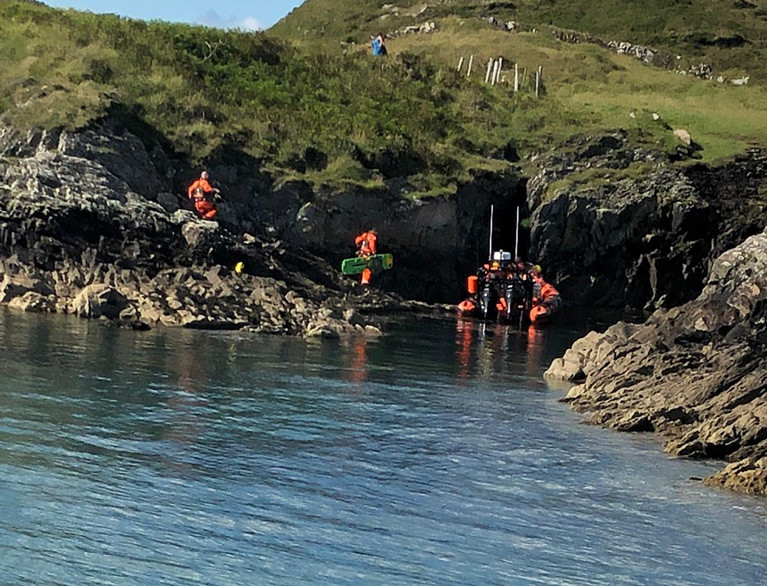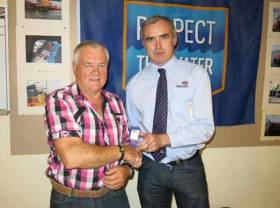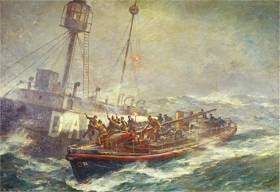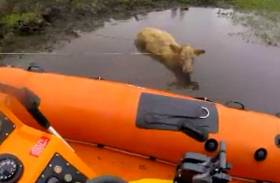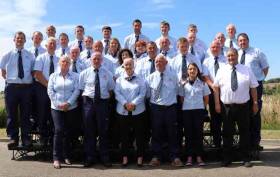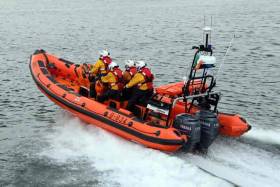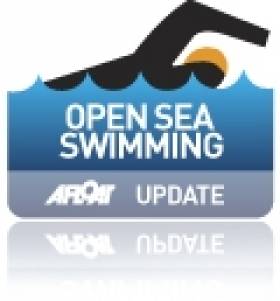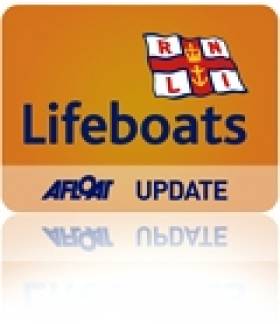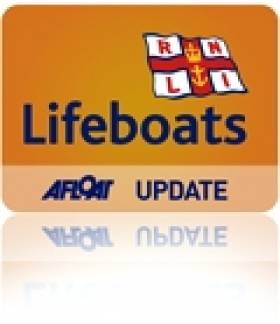Displaying items by tag: RNLI lifeboat
Lough Derg RNLI Launched to Assist Paddleboarder Clinging to Navigation Mark
On Wednesday afternoon, 15 December, Valentia Coast Guard requested Lough Derg RNLI lifeboat to launch to assist a person who reported themselves in difficulty in the water near Portumna, at the northern end of Lough Derg.
As the crew and shore crew prepared for immediate launch, they were informed that the person in the water was clinging to a navigation mark in the lake southwest of Portumna. At 4.22 pm the lifeboat launched with helm Eleanor Hooker, crew Steve Smyth, Joe O’Donoghue and Doireann Kennedy on board. The lake was near calm with southerly winds Force 1-2. Visibility was good en route to the casualty’s location.
Given the serious risk to life, Rescue 115, the Irish Coast Guard Search and Rescue Helicopter team launched from their base at Shannon. Portumna Gardaí, Portumna Fire and Rescue Crews and Galway ambulance crews made their way to a small harbour on the Galway shore known as New Quay.
As the lifeboat approached the scene, they were informed by Valentia Coast Guard that the Portumna Fire and Rescue crews, who had launched their dory, had located the casualty clinging to a navigation mark towards the western shore of the lake. The woman was taken ashore where an ambulance and crew were waiting to assist.
She had been paddle-boarding and, after coming off her board, was unable to get back on. She said she was in the water for an hour and a half before she was eventually able to use her mobile phone to call the emergency services. She was located after being able to identify landmarks visible onshore.
At 5 pm the lifeboat departed the scene and was back at the station at 5.40 pm.
Catherine Gleeson, Deputy Launching Authority at Lough Derg RNLI said she was ‘glad of the positive outcome and that the person in the water had a means of calling for help’. She advises water users if they are going afloat, to go with a friend and if you are going out alone, always tell someone where you're going and when you'll be back’.
Baltimore Lifeboat Crew Rescue Teenage Girl Who Fell Down Blow Hole On East Skeam Island
Baltimore RNLI was called out to a medical evacuation earlier this evening (Thursday 9 July) after a teenage girl fell nearly 10 metres down a blow hole on East Skeam Island, off the coast of Baltimore in West Cork.
The volunteer lifeboat crew launched their all-weather lifeboat at 5.25 pm, following a request from the Irish Coast Guard to provide medical assistance and evacuation to the 17-year-old who had sustained injuries in the 30ft fall which left her "deeply shocked", according to RTÉ News.
The Baltimore all-weather lifeboat arrived at the island within 10 minutes of launching. A member of the public was already on the scene and Schull Coast Guard's rigid inflatable boat (RIB) arrived shortly afterwards, followed by the coastguard helicopter Rescue 115.
The RIB transferred two volunteer members of the Baltimore lifeboat crew, Emma Lupton and Jerry Smith, from the lifeboat to the cave.
After assessing the situation, the girl was placed on a stretcher and removed from the cave by the lifeboat and coast guard crew.
Extraction proved difficult as the cave was very narrow and there was a rising tide at the time. Once the casualty was safely transferred to the helicopter helicopter, the lifeboat then returned to the station in Baltimore at 7.18pm.
"Extraction proved difficult as the cave was very narrow and there was a rising tide"
There were five volunteer crew onboard the lifeboat: coxswain Kieran Cotter, mechanic Cathal Cottrell and crew members Jerry Smith, Emma Lupton and Sean McCarthy. Conditions at sea during the call out were calm with a north-easterly Force 2-3 wind, no sea swell and very good visibility.
Speaking following the callout, Kate Callanan, Baltimore RNLI volunteer lifeboat press officer, said: "If you find yourself in need of medical assistance whilst at sea or on an island, call 999 or 112 and ask for the coastguard. We wish the casualty a full recovery."
In a warm tribute, the Achill Island RNLI lifeboat station’s volunteers said that it was with deepest shock, regret and sympathy to his family and his wide circle of friends that they reported the untimely passing of their esteemed former crew member, emergency Coxswain and current Deputy Launching Authority, Mattie Stafford.
Achill Island RNLI Lifeboat Operations Manager Tony McNamara said: ‘Mattie brought his many skills and ability not least in the fields of seamanship and mechanics to the Achill Island lifeboat over many long years.
‘There were few problems on land or on sea that would get the better of Mattie. He will also be greatly missed by the fishing community especially around Purteen Harbour where Mattie was for many years the ‘go to’ man to quickly sort a problem and get you to sea.
‘As a long standing and experienced crewman and Coxswain, he was generous with his time and advice to new crew and his advice was always welcomed and valued on the lifeboat in difficult situations on many occasions.’
Mattie was awarded the RNLI Long Service Medal following 20 years on the lifeboat crew. On his retirement from the crew, he took on the roles of Deputy Launching Authority and on the station operations team.
‘We will miss his advice, experience and camaraderie and the Achill Island lifeboat family will be the poorer for his untimely passing. To his wife Kathleen, his children Jacinta, Matthew, Caitriona and Genevieve and his extended family we offer our support and deepest sympathy. Ar dheis De go raibh a ainm cinealta’.
Mattie’s funeral Mass takes place at 12 noon this afternoon, Monday, in St Patrick’s Church, Pollagh, followed by burial in Slievemore Cemetery.
The family of the RNLI Coxswain who led the Ballycotton Lifeboat in the famous Daunt Rock rescue in 1936, have presented the medals which he was awarded for the rescue to Cork City Museum.
The medals, presented to Patrick Sliney, popularly known locally as ‘Patsy’, are to become part of an exhibition recalling what is still regarded as the most famous rescue in Irish lifeboat history. Eight Lightkeepers were safely taken from the then Daunt Lightvessel near the entrance to Cork Harbour during February gales that reached hurricane strength when the lifeboat was on continuous service for 49 hours.
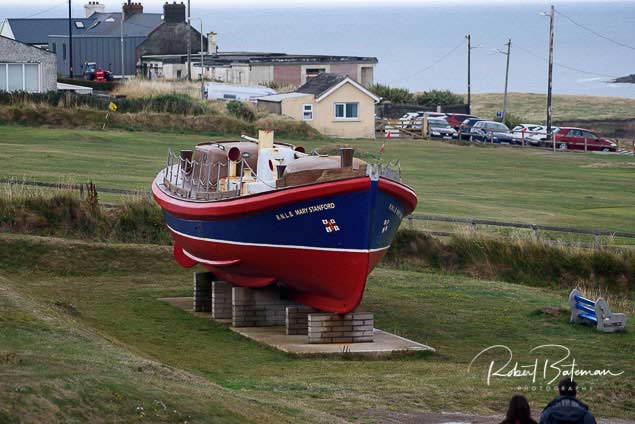 Mary Stanford displayed in Ballycotton Photo: Bob Bateman
Mary Stanford displayed in Ballycotton Photo: Bob Bateman
The Sliney family decided to present the medals to the Cork City Public Museum so that the story of the rescue can be preserved for a wide audience.
The presentation included service medals of Coxswain Sliney from the First World War.
The Museum intends to create an exhibition to commemorate Ballycotton Lifeboats and the Daunt Rock Rescue.
More on the Podcast below, including interviews with the Sliney family and the Museum Curator.
At 10.33am this morning Malin Head Coast Guard requested Lough Ree RNLI launch to assist in the rescue of a cow that was stuck in the mud at Long Island, 2 miles south of Athlone. Conditions at the time were blustery force 3-4 winds with occasion heavy misty rain.
When they arrived on scene the RNLI Crew met with the farmers who were there to discuss what assistance they could provide to free the cow who was up to her shoulders in the mud.
Two of the lifeboat crew members entered the water and got a rope around the cow’s neck to gently encourage the cow towards the shore in the hope that she could free herself. It became apparent that while the cow could move one leg at a time, she was in too deep to be able to make her own way out. One of the farmers then entered the lifeboat and the crew manoeuvred the lifeboat alongside the cow to enable the farmer to tie a halter/bridle around the cow’s head. The other farmers on the shore were then able to very gentle pull the cow out using the tractor to free her. Once ashore the cow was reunited with the rest of the herd and the lifeboat crew returned to base.
Speaking after the call out, Lifeboat Helm, Tom Bradbury said, ‘we were delighted to be able to assist the farmers in rescuing their cow and reunite her with her calf and the rest of the herd. If you see anyone human or animal struggling in the water, don’t get into the water yourself, call 999/112 and ask for the Coast Guard.
Fethard RNLI Name Lifeboat Naomh Dubhán in a Ceremony with Strong Emphasis on Community
Volunteers with Fethard RNLI gathered at the lifeboat station over the weekend (Saturday 30 June) for a naming ceremony and a service of dedication for their new lifeboat Naomh Dubhán. In glorious sunshine, operations crew, fundraisers, station management, friends and supporters came along to mark the occasion.
Oonagh Hearne Messette, Chair of the Fethard Fundraising Group represented all the members of the community, near and further afield, who had raised the funds necessary for the purchase of the €65,000 lifeboat. She passed the lifeboat into the care of RNLI Headquarters, which was represented by Joe Moore, Area Lifesaving Manager
In her remarks, Oonagh spoke about the appeal, ‘On the 20th of February 2016 we launched the Special Appeal to raise money for this Lifeboat. We completed the task in under a year. The fundraisers I am representing here are from Rinn Dubhán, which is the whole peninsula and from Carrig–on–Bannow, up to New Ross, over the river to Waterford and up to Dublin. The range of events and the money raised really shows the community spirit and commitment to our Lifeboat and by extension, the RNLI.’
Oonagh made special mention of the Waves Festival at Loftus Hall, which brought in half the total. ‘The support of Aiden Quigley, his family and staff; the sponsors, the volunteers on the day, and the organisational skill and determination of Rebecca Doyle led to an amazing unique event.’
As part of the ceremony, the lifeboat is passed from the Institution into the care of the station and its volunteers. Representing them, Tony Molloy, Fethard RNLI Deputy Launching Authority said, ‘While we are sad to say farewell to our previous boat, Tradewinds, which has served the station for the last ten years, we look forward to writing a new chapter in the station’s history with the arrival of this new D- class lifeboat.’
‘A fast and agile rescue boat, the D-class can be operated in surf, and in shallow water close to the beach. Because of its size, it is easily transported by road and launched at a number of different launch sites around the area, Fethard Dock, Slade, Duncannon, Ballyhack, St. Kearns, Barrystown and Cullenstown, depending on the location of the reported casualty.’
During the ceremony music was provided by Fethard RNLI Flash Mob Choir and Rev. Ivan Dungan carried out the service of dedication which included the lifeboat prayer.
John Hearne, Chairperson of the Fethard Lifeboat Management Group opened the proceedings and spoke of the incredible support the lifeboat volunteers received from their loved ones. He said, ‘For each volunteer with a role here at the station there are several more people in the background, maybe who didn’t actually volunteer at all for the job of being the one to keep family life on track while their other half is off life boating. And when the pagers go off and the 34 active operational members drop everything and hurry here to the station there could be someone waiting at home. While we sing the praises of the active volunteers today I want you to spare a thought for their support crew who enable them to carry on.’
The name Naomh Dubhán was chosen in recognition of the saint who came to the Hook Peninsula from Wales in 452 A.D and established a monastery. It is believed that St. Dubhán lit the first warning beacon for ships on the Hook Peninsula shortly after his arrival. This beacon was maintained by monks for 700 years until Hook lighthouse was built.
Killybegs Coast Guard RIB Takes Dive Boat Under Tow
The volunteer crew of Bundoran RNLI Lifeboat were requested to launch this afternoon to assist a dive boat with 4 persons on board, which had broken down.
The alarm was raised around 1:50pm with Malin Head Coast Guard who immediately requested the launch of the Bundoran Lifeboat and also tasked the Killybegs Coast Guard RIB.
The Bundoran Lifeboat launched at 2pm to the dive boat which was around a mile north of Bullockmore, (west of St John’s Point). The Killybegs Coast Guard rib took the dive boat under tow to Killybegs Harbour with the Bundoran Lifeboat accompanying both vessels.
On returning to the station around 90 minutes later, Volunteer Lifeboat Crew member with Bundoran RNLI Richard Gillespie said ‘the people on board the dive boat were absolutely correct to call the Coast Guard and have ourselves and Killybegs launched. While they were in no immediate danger, the longer they left the call, the more chances there were of something going wrong. We would always encourage boat users to contact the Coast Guard on the first sign of a problem so we can be there to help sooner rather than later.’
Open Sea Swimmer Steve Plans Record Swim for the RNLI
#openseaswim – Well known open water swimmer Steve Redmond from Ballydehob in Cork is about to embark on a record breaking challenge to raise funds and awareness for the RNLI. Steve has already made history for being the first man ever to complete the gruelling Seven Oceans Swim and he is now taking on his biggest challenge to date, swimming from Ireland to Wales.
Steve is a former rugby player and triathlete who has become well known for his long distance open water swims. He was the first person to swim around the Fastnet Rock off the Cork coast. Now at the age of 48 he wants to complete one more big challenge and swim the 80 kilometres from Ireland to Wales. He plans to depart from Rosslare in County Wexford in the early hours on Friday 23 August, weather permitting and swim non-stop to Wales, arriving in St. David's approximately 35 hours later.
These locations are also home to lifeboat stations in the RNLI, a charity that is close to Steve's heart. Living in West Cork and training in the sea near Baltimore lifeboat station, Steve is very familiar with the work of the charity and three of his support team are volunteer lifeboat crew with Baltimore RNLI.
Speaking on the challenge Steve said, "Sadly there have been a number of tragedies off our coast in the last few months and it has brought home to me that while the sea is beautiful it can also be dangerous. I want to do something for the people who volunteer to rescue those in trouble at sea or who have to bring loved ones home when they have lost their lives out there. I am very familiar with the work of search and rescue agencies and in particular the RNLI and it would be great to raise funds and awareness for them through this swim."
Steve is under no illusions how challenging the swim will be for him. It will be much further than he has ever swam before and will take a huge amount of strength and mental endurance. By his side for the challenge will be his support team who will keep him under constant surveillance. Steve is not allowed touch the boat or another person while he is swimming and will need to be independently observed by a member of the Irish Long Distance Swimming Association to verify the challenge. Medical personnel will also be close at hand should Steve get into difficulty and be unable to complete the swim.
He is currently swimming up to 90 kilometres a week in training and is now keen to undertake the challenge. He added, "This time last year I vowed never to put my body through another endurance swim. A year later and I am now looking forward to this next challenge, which I have always wanted to complete. The fact that this swim has never been done by one person alone makes it more enticing to me and if the weather and tides allow I am confident that I can make it. I am also looking forward to raising some funds for the RNLI who battle the elements day in day out to save lives at sea."
Steve Redmond will depart Rosslare in the early hours of Friday 23 August, weather permitting. To donate to Steve's swim in aid of the RNLI please go to: www.mycharity.ie/event/irelandtowales2013/
Fisher Entertains By the Lee in Aid of the RNLI (Photos here!)
#SAILING BY THE LEE – Maritime journalist Bob Fisher entertained over 200 guests today at the annual RNLI "Sailing by the Lee" Lunch 2012 in Cork. SCROLL DOWN FOR PHOTOS BELOW BY BOB BATEMAN.
The large crowd from the maritime community in Cork gathered at the Maryborough Hotel and Spa in Cork for the ninth annual Sailing by the Lee lunch. Kindly supported by Port of Cork and Electric Bar/Restaurant, the event was a huge success with well known faces from the maritime world and Cork's social scene gathering to raise funds for Kinsale and Crosshaven RNLI stations in their work saving lives at sea. €11,650 was raised to go directly towards operations at both stations.
The highlight of the lunch was special guest, international marine journalist Bob Fisher, who had flown in from the UK for the event. Following; an introduction via Skype from Canada by International Marine Architect Ron Holland, Bob recalled his experiences over some 70 years as a world renowned journalist, capturing history unfolding in the worlds of ocean & inshore racing, cruising and the friendships inevitably made.
During the lunch, RNLI Patron Donal McClement paid a special tribute to Bob on his remarkable career, "I wish to acknowledge Bob's absolute dedication; commitment and enthusiasm in representing those connected to the sea, in bringing the thrills and excitement of events such as the Admiral's and America's Cup back to us at home and capturing the ongoing challenges and adventures of the international maritime community."
Bob Fisher is best known for capturing the America's Cup throughout the years and has published extensively on this and other leading events.
Familiar well known faces who attended on the day included Donal McClement, Peter & Marie Crowley, Conor & Mauritta Doyle, Anthony & Sally O' Leary, Vinny O' Shea, Naval Captain Bob Scarret, Port of Cork's Capt McCarthy, Alan Barton, John P O' Gorman and Tom McSweeney.
Speaking after the event, RNLI Governor Peter Crowley stated:-
"Our sponsors and supporters for this year's event have been extremely generous and we are very grateful to them, particularly given the challenging economic climate. In particular, I would like to thank Port of Cork and Electric Bar & Restaurant, South Mall. We are delighted to have Bob Fisher and his wife, Dee with us this year-with their help, we raised sufficient funds today to replace and update all crew lifejackets at both the Kinsale and Crosshaven Stations."
New Lifejackets for Irish Lifeboat Crews
#RNLI – The RNLI has launched a campaign which will see every lifeboat station in Ireland take delivery of new specially designed lifejackets this year. The lifejackets have been commissioned by the RNLI for search and rescue work and have been given the seal of approval from lifeboat volunteers.
Irish lifeboat crews at Dun Laoghaire, Wexford and Bangor were involved in the trials. Every aspect of a search and rescue operation was examined with the lifejackets designed to work in conjunction with the lifeboat volunteer to protect them and to aid their work.
The RNLI operates 43 lifeboat stations in Ireland ranging from the operation of inshore lifeboats up to all weather lifeboats capable of going one hundred miles out to sea. The cost of providing the lifejackets is estimated at €160,000 with costs at each station ranging from €2,500 up to €5,500. The charity is hoping that its national SOS fundraising day, to be held on Friday 27 January, will help raise some of the funds needed.
The RNLI continually looks to advance and improve its safety equipment. In the 1850s narrow strips of cork were sewn onto a canvas vest so the lifejacket could move with the body. Today crew lifejackets reflect decades of technological advancements. The new designs are more ergonomic and fitted to let the individual swim unhindered to aid casualties. They are lighter and more buoyant and will support the weight of a casualty being brought to safety by a crewmember in the water. They also have a luminous spray hood with visor, which can be pulled over the crewmembers head if they are in water to protect against sea spry while also making them highly visible. The lifejackets also come fitted with all the industry standard features such as water activated emergency lights, integral flare pockets, crotch straps and zipped pockets for casualty care cards, torches, gloves or knives.
Martyn Smith, RNLI Divisional Inspector for Ireland said, "Lifejackets are an essential piece of every lifeboat volunteer's kit. Whether they are operating from their lifeboat or recovering a casualty from the sea, their lifejacket is a lifesaver. This new design which is specially developed for search and rescue has some very important features that will aid them in their work. Replacing and updating our lifejackets is an ambitious project but one we feel is important as our crews deserve the best in equipment. I am grateful to the Irish lifeboat stations who trialled the lifejackets, they have helped deliver an outstanding piece of life saving equipment."
Emma Gibson, RNLI Area Fundraising Manager added, "The RNLI is a charity that relies on the generosity of the public and we are asking people to help us equip our lifeboat volunteers. Our national SOS fundraising day will take place on Friday 27 January and for this one we hope people will do something to help us raise funds for these new lifejackets.
The RNLI will also recycle the individual parts of the old lifejackets that have come to the end of their operational life, from steel and brass components to the fabric. If people wish to help or get involved with Lifejackets for Lifesavers they can call the RNLI on 01 895 1800 or email [email protected]


























